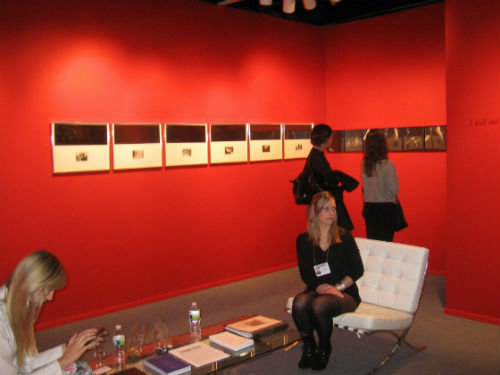New York City's longest-running fair, The Art Show is a small gem and a successful fair, if for no other reason than a steady stream of return customers. Art Fag City spoke with several galleries who show at both The Armory Show and The Art Show and asked them why they prefer showing at each venue.*
Gallerists from Donald Young Gallery, Greenberg Van Doren Gallery, and Fraenkel Gallery referred to ADAA buyers as “consistent,” showing up year after year. These buyers, for the most part, come from an Upper East Side clientele. I can attest to this first-hand: the ADAA, more than any other fair, gets an “after-work” rush. On Wednesday afternoon, I arrived to a sleepy fair, but after 6:30, the place suddenly began to perk up.
Even with the crowds, the ADAA was notably slower-paced than The Armory Show. John Van Doren, whose gallery has a booth at both fairs, explained that at the ADAA, “You can have a conversation [about the works].” At almost every booth I visited, gallerists sat around in chairs, chatting with visitors; more than an art fair, the ADAA is a parlor room.
Whether that curiosity and friendliness will translate into sales can't be certain until the end of the week, but by the time I arrived on Wednesday night, David Zwirner Gallery had sold out its booth entirely and Marian Goodman Gallery had sold all but one work from its solo booth of Francesca Woodman. Other galleries, like L & M Arts and Metro Pictures, have also noted brisk sales.
Although the ADAA has its merits, it doesn't have everything. Twelve galleries who showed at this year's Art Show—a sixth of the total exhibitors—also made appearances at The Armory Show across town. For the galleries I spoke with, the advantage of The Armory lies in the appeal of an as-yet-untapped collector base. Dealers spoke of attracting a new, international audience at The Armory Show—in contrast to the Upper East Side's old guard.
Bella Hubert, from David Zwirner, described the gallery's return to the Armory in terms of attracting a “younger, more international, cutting edge” crowd. Christian Alexander, from Peter Blum Gallery, explained that the gallery always does both fairs in New York; since their only other art fair stop is Art Basel Miami Beach, it makes sense to take full advantage of the international audience available during Armory Week.
In keeping with the younger crowd, Zwirner showed up to the Armory with younger art, showing Michael Riedel (b. 1972) at the larger fair and Susan Frecon (b. 1941) at the ADAA. Peter Blum Gallery described a similar propensity to show different types of work at each fair. At the ADAA, the gallery brought a quiet solo show by Adrian Paci, whose reductive color palette ranged all the way from silver gray to charcoal gray. At The Armory, things were a bit more lively, and included a splashy, cherry red canvas by John Zurier and a roughly hewn sculpture by Esther Kläs, among works by several others.
Although it may pay off to be subdued at the ADAA, a little grit and novelty is preferred at the larger show; as we said last year, Armory buyers notice about the same things a cat would. Here lies the difference between the art and sales at the two fairs: The Art Show relies on a predictable collector base, but The Armory Show brings in the excitement of a younger, ever-changing, scene of international collectors.
*The full list of galleries showing at The Armory Show and The Art Show in 2012: Peter Blum Gallery, CRG Gallery, DC Moore Gallery, Greenberg Van Doren Gallery, Greene Naftali Gallery, Hirschl & Adler Galleries, Michael Kohn Gallery, Nicole Klagsbrun Gallery, Pace Prints, Susan Sheehan, Pavel Zoubok Gallery, and David Zwirner Gallery.



Comments on this entry are closed.